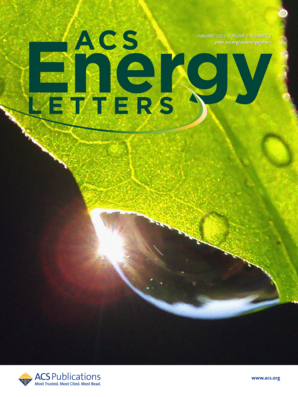Origin of the Low Overpotential for Isopropanol Oxidation on Pt–Ru Electrocatalysts
IF 19.3
1区 材料科学
Q1 CHEMISTRY, PHYSICAL
引用次数: 0
Abstract
Electrochemically active liquid organic hydrogen carrier (EC-LOHC) technology is an emerging solution for safe and environmentally friendly hydrogen storage and energy conversion based on the use of organic redox-active compounds, such as the isopropanol/acetone couple. In this work, we identify the nature of the active state of the Pt–Ru electrocatalyst that provides the lowest overpotential and, thus, the highest catalytic activity. Toward this aim we employed ex situ electrochemical synchrotron radiation photoelectron spectroscopy (SRPES) and scanning tunneling microscopy (STM) in combination with in situ electrochemical infrared reflection absorption spectroscopy (EC-IRRAS). We show that the lowest overpotentials are not observed for Pt–Ru surface alloys but only in the presence of ultrasmall metallic Pt aggregates formed by dealloying of Pt–Ru catalysts upon oxidation and reduction cycles between 0.0 and 1.5 VRHE. By tuning the initial composition of the Pt–Ru surface alloy, we maximize the density of active Pt aggregates.

异丙醇在铂-钌电催化剂上氧化的低过电位起源
电化学活性液态有机氢载体(EC-LOHC)技术是一种基于有机氧化还原活性化合物(如异丙醇/丙酮夫妇)的安全、环保的氢存储和能量转换新兴解决方案。在这项工作中,我们确定了铂-钌电催化剂活性状态的性质,这种状态可提供最低的过电位,从而提供最高的催化活性。为此,我们采用了原位电化学同步辐射光电子能谱(SRPES)和扫描隧道显微镜(STM),并结合原位电化学红外反射吸收光谱(EC-IRRAS)。我们发现,在 0.0 至 1.5 VRHE 之间的氧化和还原循环中,铂-钌催化剂脱合金形成的超小金属铂聚集体存在最低过电位,而铂-钌表面合金则不存在最低过电位。通过调整铂-钌表面合金的初始成分,我们最大限度地提高了活性铂聚集体的密度。
本文章由计算机程序翻译,如有差异,请以英文原文为准。
求助全文
约1分钟内获得全文
求助全文
来源期刊

ACS Energy Letters
Energy-Renewable Energy, Sustainability and the Environment
CiteScore
31.20
自引率
5.00%
发文量
469
审稿时长
1 months
期刊介绍:
ACS Energy Letters is a monthly journal that publishes papers reporting new scientific advances in energy research. The journal focuses on topics that are of interest to scientists working in the fundamental and applied sciences. Rapid publication is a central criterion for acceptance, and the journal is known for its quick publication times, with an average of 4-6 weeks from submission to web publication in As Soon As Publishable format.
ACS Energy Letters is ranked as the number one journal in the Web of Science Electrochemistry category. It also ranks within the top 10 journals for Physical Chemistry, Energy & Fuels, and Nanoscience & Nanotechnology.
The journal offers several types of articles, including Letters, Energy Express, Perspectives, Reviews, Editorials, Viewpoints and Energy Focus. Additionally, authors have the option to submit videos that summarize or support the information presented in a Perspective or Review article, which can be highlighted on the journal's website. ACS Energy Letters is abstracted and indexed in Chemical Abstracts Service/SciFinder, EBSCO-summon, PubMed, Web of Science, Scopus and Portico.
 求助内容:
求助内容: 应助结果提醒方式:
应助结果提醒方式:


